Preamble
Before we jump into the "real" purpose of my blog, I want you to look at this GameSpot Tweet and realize how older we are right now.
The best games that turn 10 this year https://t.co/HU5jkEjbKBpic.twitter.com/jUku9ZmMUn
— GameSpot (@GameSpot) April 21, 2019
While people champion 2008 as one of the most significant individual years in video games, 2009 remains unfortunately forgotten. However, it shouldn't as heavy-hitters like Batman: Arkham Asylum, Assassin's Creed II, Call of Duty: Modern Warfare II, Uncharted 2: Among Thieves, and Borderlands all proved to be significant moments in the industry. Additionally, some of these games reinvigorated long-dormant genres, whereas others elevated franchises to near legendary status. Sadly, 2009 is also notable in another regard. By that point, the end of the "B-Tier" game was all but guaranteed.
Admittedly, we are a year away from THQ's uDraw tablet, a device which doomed the industry's doyenne of B-Tier development. Nonetheless, other events spelled the end of the "B-Game." In 2008, the release of Braid legitimized small-scale indie games. Call of Duty 4 set a new gold standard for online multiplayer. Finally, Gears of War and Uncharted 2 increased consumer expectations for single-player campaigns. If one were to go back to 2009 and attempt to establish a video game company, they would struggle. The industry was, as it is today, in "flux." Large studios were moving away from publishing a small collection of high budgeted games in favor of portfolios of several smaller-scale projects.
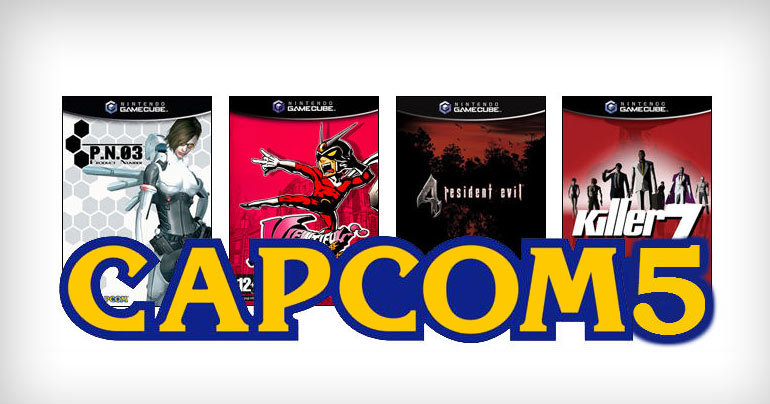
Somehow, Capcom did not get that memo in 2009. Case in point, look at Capcom's releases from 2009 to 2010. While there are a handful of heavy-hitters like Super Street Fighter IV or Monster Hunter Tri, everything in-between is a video game desert. It's by a stroke of luck Capcom was able to churn out two Monster Hunter games in this period, because everything else appears financially ruinous. Lost Planet 2, Bionic Commando (2009), and Dark Void were well-known financial disappointments. But this is ignoring an important fact about Capcom in the late 2000s; they were making games at a breakneck speed. In 2009 alone, they released around fourteen to fifteen games! So, the question remains, why would any video game company engage in such accelerated production cycles?
Before I answer that question, I should probably address the comment many of you are likely shouting at the top of your lungs. Grouping Capcom on par with developers like THQ seems decidedly mean. For the most part, I agree with this sentiment; nonetheless, Capcom is a bit of an odd case. While yes, they are a preeminent fighting game developer, more often than not, Capcom engages in behavior similar to that of a mid-2000s B-Tier developer. Case in point, look at the development and release of Bionic Commando (2009). Even back in the day, it reeked of a publishing model ten-years out of date.
Speaking of Bionic Commando, let's add some context to why the game was made in the first place. In the years following the release of Gears of War, Capcom decided to have a go at the modern third-person shooter genre. A few years earlier, Capcom experienced moderate success in this genre with Lost Planet, and by 2009, they were busy developing Lost Planet 2. Nonetheless, Capcom was hungry to have more skin in the game and contacted the Swedish developer GRIN. GRIN caught Capcom's attention as they had a reputation of working on tight schedules and within even tighter budgets. From 2008 to 2009, GRIN churned out FIVE video games, and thus fit with Capcom's essence at the time. Be that as it may, as Capcom was busy managing its affairs, GRIN developed Bionic Commando Rearmed and Bionic Commando (2009) with little to no guidance from Capcom. While many developers would jump at an opportunity to make a modern rendition of a timeless classic with complete creative freedom, GRIN struggled to triage the two projects. Which leads us to our first burning question:
Why Is Bionic Commando Rearmed So Much Better Than Bionic Commando (2009)?
Alright, I admit, that's a bit of a loaded question, but it allows us to examine GRIN more thoroughly before we jump into Bionic Commando. While this blog will mostly look at the misadventures of Bionic Commando, I cannot preface enough how GRIN nailed Bionic Commando Rearmed. Rearmed manages to strike an incredible balance between new-school and old-school sensibilities. Likewise, the game has a thoroughly enjoyable swagger and aesthetic. Nevertheless, the craft put into Rearmed presents our first burning question: why is it so much better than the 2009 reboot? Most believe the smaller scale of Rearmed proved advantageous to GRIN's tight development schedule. However, I have a personal theory GRIN prioritized the development of Bionic Commando Rearmed over the 2009 reboot.
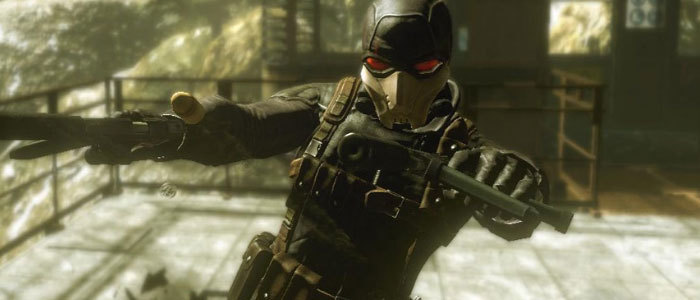
So, where do I, an amateur blogger, get off logging this accusation? For one, GRIN's enthusiasm for Rearmed, over the 2009 reboot, was public knowledge. Capcom Unity started a podcast series that chronicled the development of Bionic Commando. In this podcast, the number of times GRIN employees change topics about the reboot in favor of Rearmed is shocking. On one such podcast, I recall a developer gushing over adjusting Rearmed's gameplay to work with a 3D engine, and needing to dismiss conventional physics. While Capcom Unity certainly painted a rosy picture about the Bionic Commando reboot, their discussions were mostly superficial. In one episode, the podcast's hosts are decidedly excited about the Mohole boss encounter. What the podcast does not tell you is the Mohole is one of only three bosses in the entire game. Therefore, it is safe to assume the reboot's developmental struggles were common knowledge at Capcom Unity.
However, the current collection of evidence favors the traditional argument of why Bionic Commando failed. That is to say; the game was developed under stressed and resource-poor conditions. The first piece of evidence to support this notion is GRIN was busy plugging away at another console shooter, Wanted: Weapons of Fate, when they started talks with Capcom. As Bionic Commando's release drew closer, GRIN took on a new contract to develop a video game adaptation of Terminator Salvation. Furthermore, from 2008 to 2009, GRIN would be responsible for the development of FOUR video games! For an independent development studio, that rate of production is unsustainable, and the consequence was the quality of their games suffered. After attracting critical acclaim for their work on Bionic Commando Rearmed, the same recurring criticisms plagued their future releases. Bionic Commando and Wanted were both excoriated for their short campaigns, and Terminator Salvation was a late-2000s movie-to-video game adaptation.
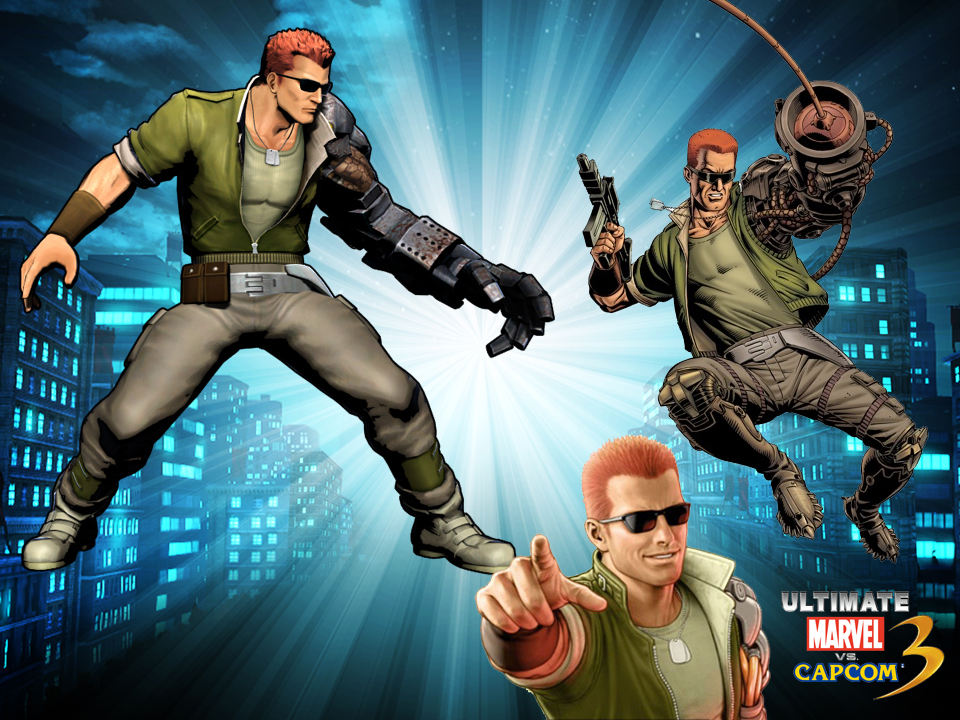
So, where does that leave Bionic Commando? First, GRIN was cash-strapped and financially coasting on fumes. Wanted sold so poorly Universal Pictures completely pulled out of the video game market, and things were not looking favorable for Terminator Salvation. To make matters worse, Capcom's laissez-faire approach to GRIN left the developer on its own when they needed help. Had Capcom assumed a more proactive role in monitoring the project, they could have averted many of the game's shortcomings. However, Capcom itself was stretched thin, and their Western studio was an understaffed shell company. All of these compounding issues meant Bionic Commando's reboot was all but destined for failure.
But What About Bionic Commando (2009)?
When I installed Bionic Commando earlier this year, I went into it with tempered expectations. I knew about the game's moronic plot twist and unintentionally hilarious sense of grittiness. I also recalled the game's swinging mechanic being incredibly ambitious. All the same, the game's unfinished roughness caught me by surprise. I would go so far as to suggest Bionic Commando is the most top-heavy game I have ever played! While a glance at any online guide might indicate the game has as many as fifteen levels, the first two environments do most of the heavy lifting.
Moreover, most of your time is spent looking at the same destroyed apartment complexes or industrial shipyards. At times, you feel as if the game was designed using the "ctrl+v" shortcut. The levels that add some much-needed visual variety are too few and far between. Even more troubling, the later portions of the game are shockingly brief. One of those chapters, the game's finale mind you, is an extended quick time event. Finally, it baffles my mind how little of the game ends up serving Bionic Commando's main selling point, Nathan's robotic arm. The vast majority of the levels are dreadfully horizontal and actively discourage exploration. For example, when the game tasks you with summiting a skyscraper, it directs you to a ground-level entry point and forces you to explore the building by foot.
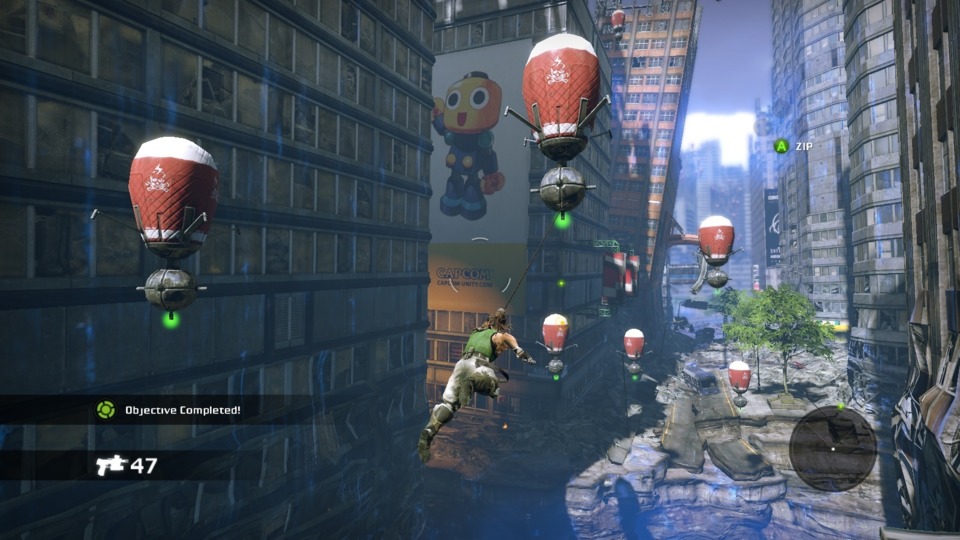
Speaking of which, let's address Spencer's grappling arm. As a friend of mine once put it, the grappling mechanic is single-handedly the best and most disappointing aspect of the game. When the game utilizes open-world environments that do not immediately punish you for miss timing grapples, it allows for enthralling moments of exploration and experimentation. In these environments, I will not deny enjoying practicing how to reach an optimal apex. Regrettably, even in the game's "safe" environments, achieving a sense of flow is hard to accomplish. Again, part of this problem is due to the game's design. Patches of radiation often limit your ability to explore environments, and their purpose of funneling the player is nakedly transparent. As such, the game's linearity is in constant conflict with the free-flowing nature of the bionic arm.
Likewise, not enough of the game empowers you to use Nathan's arm. The core mechanic of the game is the joy of swinging through open worlds like a bionic Spider-Man. Unfortunately, the vast majority of the levels are linear stomps through two or three distinct permutations of futuristic industrial parks. These environments are incredibly tight. To boot, annoying environmental hazards often litter these levels. In later portions of the game, missing a single leap will cause Spencer to fall into a pit or ocean. Moreover, the game ramps up its difficulty when it introduces several enemy types that can resist your bionic arm. Every step of the way, there's at least one thing in each environment preventing you from un-tapping the bionic arm's full potential.
Above all, GRIN's Bionic Commando simultaneously attempts to be a modern third-person shooter. Here it fails in every regard. I'm partially sympathetic to this problem because Bionic Commando is caught in the same dichotomy as Mirror's Edge. In both cases, if the developer makes shooting too viable of a strategy, players will likely ignore the central conceit of the game. Nevertheless, what boggles my mind is large swaths of Bionic Commando force you to resort to conventional weapons. For example, a helicopter boss is quickly dispatched using a rocket launcher, and the game actively discourages you from using the robotic arm. Near the end of the game, there is a loathsome shootout at an abandoned library where there isn't enough junk to throw at enemies.
A more fundamental issue is the progression of Spencer's arm. For one, the game starts you without the bionic arm, and you have to slog through a miserable number of third-person action sequences before getting it. Likewise, the game utilizes a bizarre skill-based leveling system wherein killing enemies a certain way, makes different parts of the arm stronger. While this certainly sounds nice on paper, it also means sequences that require a specific style of play can become untenable if you have not leveled up that skill set. Additionally, it's not until the game's middle-act when it provides its first "real" open-world environment. For the first third of the game, players stomach through several combat-heavy shootouts in the same blown-out cityscape. There, your only opportunity to practice the swinging mechanic comes when you need to vault across large pits using conveniently placed blimps. Unfortunately, because these balloons hover over chasms or bodies of water, mistiming a single vault can result in an instant "game over."
Let's Talk About The Story And That Plot Twist... You Know, THAT Plot Twist
Bionic Commando (2009) has a story, or so I am told. For most, their only impression of Bionic Commando's narrative is its moronic plot twist. While this story pivot is rightfully admonished, it overshadows other elements of its narrative. Without a doubt, Bionic Commando is one of the "ugliest" stories one can experience in a video game. There are no characters worth rooting for, and the occasional interjections of patriotic jingoism are utterly repulsive. For instance, Joseph "Super Joe" Gibson and an unnamed general constantly bark at Nathan demanding he "serve his country." You know, the same country which threw him into prison for simply having a bionic arm. Yup, everyone in this game SUCKS!
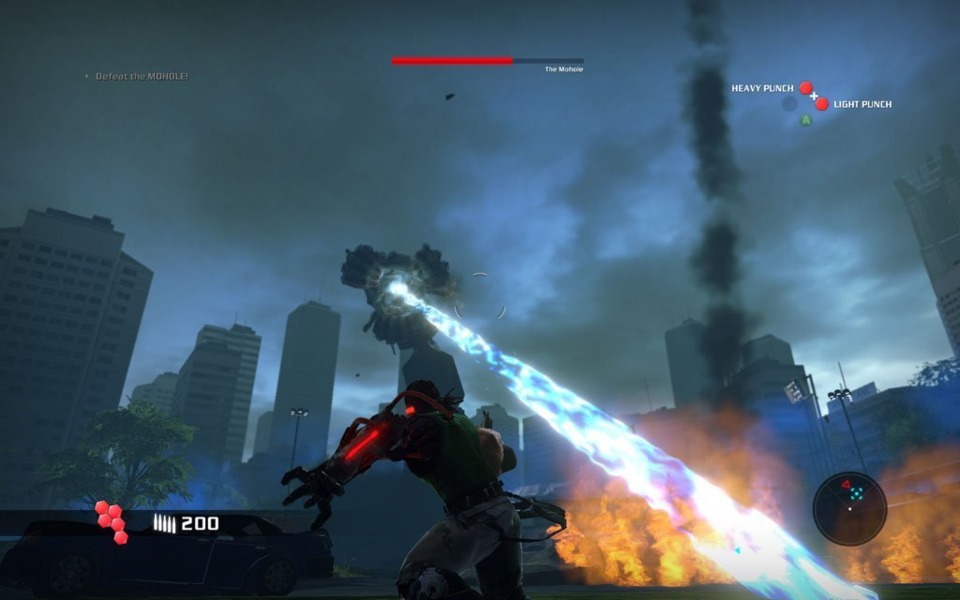
Summarizing Bionic Commando's story is simultaneously an easy task and a nightmare. It is an easy task because the storytelling amounts to about twenty minutes worth of cutscenes. I shit you not, someone on YouTube compiled every cutscene in the game, and their video amounts to about eighteen minutes. Conversely, the story is a nightmare because it attempts several different plot beats in its limited time. At first, the game tries to draw parallels to the Bush administration when it paints the activities of the government as morally questionable. Then, the story hits you with a lethal dose of jingoism when the main antagonist is revealed to be a Nazi. Eventually, when we discover the origins of Nathan's arm, I suspect the game is attempting to rebuke transhumanism.
Of course, the tone of the game is unflinchingly gritty. In many ways, it is cut from the same cloth as Gears of War or Deus Ex: Human Revolution. The worst example of this is when the characters pantomime emotions meant to sweep the player into a dramatic tale of redemption. As Spencer galavants through the charred remains of Ascension City, he eventually encounters another named bionic, Jayne "Mag" Magdalene. Mag is a member of a terrorist organization that detonated a nuclear weapon in Ascension City. Mag justifies her actions by claiming the government was aiming to take away her bionic legs. Because, you know, prosthetic limbs weren't going to cut it. When Spencer attempts to confront Mag about her actions, he says, and this is not a joke, "By the way, that's people you're breathing!" Seriously, this is an actual line of dialogue in this game. If you don't believe me, here's the cutscene:
Speaking of the characters, they also highlight how Bionic Commando is, at most, halfway complete. There are a total of SIX named characters in Bionic Commando. One, the general of the Tactical Arms and Security Committee, remains unseen and only interacts with Nathan through "walk and talk" story sequences. Another character, named "Thomas Clarke" has two scenes and not once feels connected with the events of the story. That leaves Nathan, Mag, and Super Joe as our connective tissue when moving from one chapter to the next. As mentioned earlier, there isn't a ton of storytelling using in-game cinematics. As a result, most of the characterization and worldbuilding is done through hackable terminals littered throughout the world. However, we do not learn anything of consequence through these terminals. In one groan-inducing moment, we read about a security guard asking Mag if she was "more than platoon-mates" with Nathan.
Finally, there's the game's much-ballyhooed "plot twist." The twist itself is the single most talked about aspect of Bionic Commando. Those who have never played the game will state as fact Nathan's arm is the re-purposed remains of his wife. However, many forget this is never outright stated in the game. What we receive instead is a long-winded monologue by Super Joe, wherein Joe drones about biotics requiring a mental and biological connection with their hosts. As Nathan chases after Super Joe, he glances at a PowerPoint slide with a comedic arrow pointing at his arm and his wife's name displayed nearby.
It's unknown what GRIN's long-term plan was for this revelatory moment. Is this reveal meant to be a witty criticism of the transhumanist movement? Is this pivot another attempt to inject "grit" into the narrative? The world will never know because like every moment in this game, it juxtaposes to a new plot beat without pomp or circumstance. Just as we begin to grapple with the prospect of Spencer's arm being his wife, we watch Super Joe unceremoniously murder Mag. Then, we have to stomach through two long-winded explanations about "Project Vulture" and Super Joe's plan for world domination.
This plot point raises the issue of Bionic Commando's narrative "ugliness." Bionic Commando is a mean and depressing story to watch. Just as we learn more about Magdalene, Super Joe promptly murders her. Which reminds me, Super Joe revealing himself to be a Nazi double-agent is a complete betrayal to anyone with even the slightest bit of nostalgia for the "Golden Age of Capcom." Here we have a classic character becoming a monster with little rhyme or reason. On top of that, the game's ending is a fever dream. Super Joe commands an army of robotic vultures, but Nathan swings to him and head-butts him to death. In the game's final moments, we watch Nathan fall to what we assume to be his demise. It is a sudden and dark turn that honestly comes out of nowhere and leads to nothing.
Remember When Nathan "Rad" Spencer Was In Marvel vs. Capcom 3: Fate of Two Worlds?
The story of GRIN and Capcom following the failure of Bionic Commando is almost a story in and of itself. To summarize, Capcom hated the final version of GRIN's full-fledged Bionic Commando game. This fiasco, coupled with the failure of Dark of Void, led to them terminating all business relations with Western developers until DmC: Devil May Cry. Keiji Inafune has gone on record saying working with GRIN was "messed up," and further added, "I don't even know what happened there." These statements coincided with Jun Takeuchi, of Resident Evil and Onimusha fame, stating he disliked working with a Western affiliate during Lost Planet 2's development. On Capcom's actual website, Takeuchi straight up says: "Cultural differences don't allow for the smooth collaboration between Japan and developers overseas."
Consequently, the Capcom of the early to mid-2000s all but ended. Capcom slowed development and became a far more insular company. While Capcom has always ebbed and flowed in terms of cultural relevancy, there's no doubting the company entered a creative recession following 2009. They are, without a doubt, a continual dominant force in the fighting game market, but 2009 represents a turning point in the company's history. I'm not going to claim the company is financially on the rocks or heading in the wrong direction. This year they achieved critical success with the release of Devil May Cry 5. And, we are, of course, ignoring Monster Hunter: World, which at this point, I suspect prints actual money. Capcom is a well-oiled machine but looking at them more closely; you'll see how risk-averse they are today.
Take, for example, Okami. In the thirteen years since its release, every modern console imaginable has some version of it available to play. The game has experienced a modern-day renaissance, but there's a fundamental issue with the game, and how it relates to modern-day Capcom, which remains unaddressed. Simply put, Okami is not a game that would see the light of day in the Capcom of today. To their defense, being a modern-day video game publisher is no easy task. Additionally, if I have learned anything from the 8-4 podcast, being a large-scale Japanese video game company is even harder.
Nonetheless, let's address the question of this section of the blog. Capcom might be unflinchingly afraid of developing new IPs, but that does not mean they do not celebrate all parts of their history. Hence, we have "Spencer" in Marvel vs. Capcom 3, donning his beat-up green jumper and horrible dreadlocks as he goes up against the likes of Dr. Doom and Ryu. And HOT DAMN, do I love his inclusion so very much! Lest we not forget, he is the protagonist of a hot mess that loss Capcom millions of dollars and Capcom does not give a flying fuck! The last we saw Nathan "Rad" Spencer, he was busy ripping the guts out of robotic vultures and falling to his death. Now, most people remember him being one of the most useful characters in Marvel vs. Capcom 3, and whose ending involves him going on a date with She-Hulk.
This blasé attitude leaves Bionic Commando's "legacy" in our hands. Do we remember it for its storytelling blunders? Do we recognize it for being an emblem of a bygone era? Do we celebrate it for its mechanical ambition? Do we admonish it for putting hundreds of people out of work? I'm not going to be your daddy and tell you what to think. I ask these questions to provoke you into thinking if even failures in the video game industry have some unmistakable imprint in our memories. My impression is they do, but there's no clear-cut answer here.
Before we end, it would behoove me to mention GRIN's fate following the release of Bionic Commando. In its first month of publication, the game sold under 30,000 copies. For those not in the video game business, that is not a "good" number. GRIN's next release, Terminator Salvation, sold approximately 43,000 copies in its first month. While a slight improvement, it wasn't enough to keep the studio operating. GRIN would shutter its doors later in the year as a result of its "unsustainable cash flow." If there is a silver lining to be had, many of the individuals from GRIN are still active in the industry. However, there's one more twist to this already hazardous tale of video game hubris: GRIN had a contract that could have saved their company. That contract was with Square-Enix, and the canceled project, titled "Fortress," may well be one of the wildest stories in video game history. But that tale is for another day.
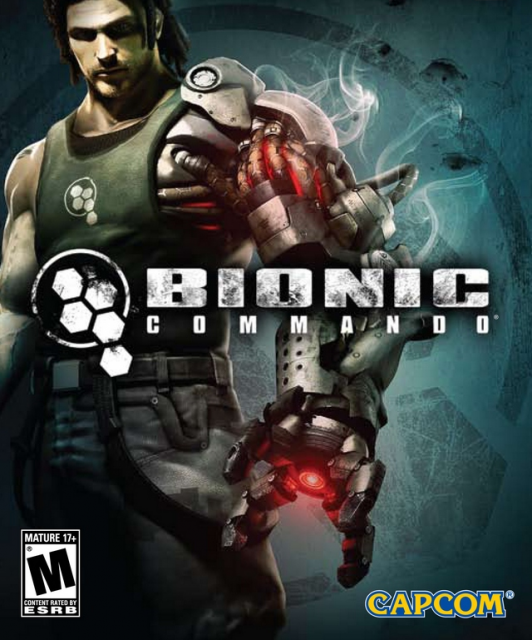
Log in to comment